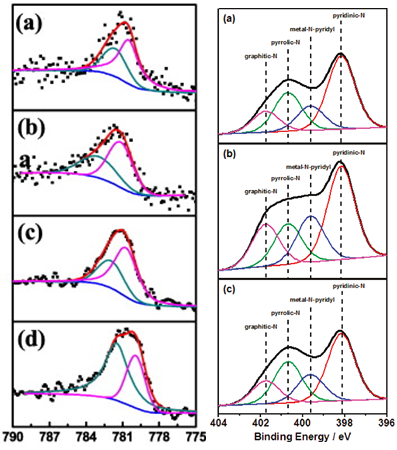
Therefore doping of DLC may provide an approach to controlling the protein adsorption.

On the contrary, the experimental XPS spectrum showed a broader profile at X 0.4 and the more detailed doping dependence of XPS (Fig. It is interesting to note that the Raman 2D peak has shown red-shifted from at 2,667 to 2,671 cm 1 for graphite and exfoliated graphite, respectively, indeed became a more symmetric 2D band. The peak at X 0.4 was expected to be narrower than the peak at X 2.3 since it would decrease the variation of nitrogen components due to decreased damage by nitrogen sputtering. It was seen that the carbon concentration increased (50.671.9 at) while both nitrogen (2.32.0 at) and oxygen (47.026.1 at) concentrations were found. The insert (on top) represents the ball-stick model of N and B co-doped graphene based on Raman spectroscopy and XPS analysis. This indicates more nitrogen vacancies are formed in the beginning of the film, and the atmospheric oxygen compensates those vacancies. These results from SE show that an adsorbed layer of glycine is higher at low silicon doping whilst increased doping levels led to a reduced adsorption compared to undoped DLC. The overall percentage concentrations of the carbon, nitrogen, and oxygen atoms were determined by taking the integrated peak areas of the C1s, N1s, and O1s from the XPS survey spectra. XPS study of the films confirms the formation of ZnN bonds, and it was found that the intensity of N1s peak reduces whereas O1s peak intensity increases as we go deeper in the film. Both XPS and FTIR spectroscopy confirm that glycine was bound onto the surfaces of the DLC and Si-DLC films via interaction of ionized carboxyl groups and the amino group did not play a significant role in the adsorption of glycine. From Fourier transform infrared (FTIR) spectrum, the peaks occur the following functional groups were assigned as COO R, COŌ, NH 3 +, NH 2, C H and C C N. The properties of nitrogen centres acting either as hydrogen-bond or Brnsted acceptors in solid molecular acid-base complexes have been probed by N 1s. This gives an indication of the quantitative change in the amounts of C, N and O on the surfaces. XPS is a quantitative technique in the sense that the. Following exposure to solutions containing (0.001 M) glycine, for undoped DLC the peaks at ∼285.0, ∼399 and ∼532 eV reduced in intensity and for Si-DLC samples, the peak at 100 eV was reduced. nevertheless identification of chemical state based on peak positions requires careful analysis. For undoped DLC the spectra show peaks at 285 eV (C 1s), 532 eV (O 1s) and in the case of Si-doped DLC films a band at ∼100 eV (Si 2p) is observed. The chemical composition of the surface before and after adsorption was analyzed using X-ray photoelectron spectroscopy (XPS). The effects of surface morphology on the interaction of glycine with doped and undoped DLC films have been investigated. 12 tried to fit XPS spectra found N-5 to be more difficult to decompose than six- using an additional binding energy of 399.4 corresponding membered rings. The adsorption of glycine onto prepared samples has been investigated with a range of surface analysis techniques. nitrogen 1s photoelectron spectroscopic signature is reviewed, and limitations on assigning precise chemistries to individual spectral ranges are discussed.

DLC and silicon doped DLC synthesized on silicon wafer substrate by using plasma enhanced chemical vapour deposition (PECVD). Level position compared to that of the undoped zinc oxide. Graphene grown from pyridine at 930 ☌ (with 1 sccm of hydrogen flow) had a nitrogen/carbon ratio of 3, and from the N1s peak analysis the nitrogen atoms appear in quaternary form (i.e., inserted into the graphitic lattice). XPS spectra of nitrogen-doped ZnO films are charac- terized by the presence of weak N 1s lines. Recently Chen and Burda 44observed N 1s level at 401.3eV from a detailed XPS investigations of nano-TiO 2 and suggested that there is NTiO bond formation due to nitrogen doping and no oxidized nitrogen. They observed N 1s core level at 400eV and hinted at a lower valence state for N.

The peak position varies from 283.97 eV for graphene on Pt(111) to 284.83 eV for. controversy in the assignment of N 1s peak position. These bonds affect the shape and position of the carbon 1s response. Suremix 30 Carbon Dioxide / 70 Nitrogen From 37. Diamond-like carbon (DLC) coatings are extremely useful for creating biocompatible surfaces on medical implants. XPS spectra confirmed the presence of nitrogen in pyridine-films grown at temperatures below 1000 ☌. The presence of the nitrogen 1s core level in the XPS survey spectrum could be caused either by adsorption or/and incorporation of nitrogen into graphene with the formation of CN bonds. It aims to compensate for the gradual lowering in the brow position that occurs with ageing.


 0 kommentar(er)
0 kommentar(er)
